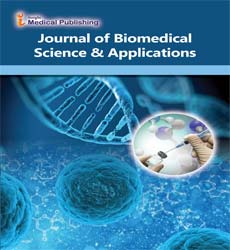Nanotechnology in Biomedical Science: Emerging Therapeutic Strategies
Atsushi Harm
Department of Biomedicine, George Mason University, Fairfax VA 22030, USA
Corresponding author:
Atsushi Harm,
Department of Biomedicine, George Mason University, Fairfax VA 22030, USA;
Email: atsushi@harm.edu
Received date: January 01, 2025, Manuscript No. Ipbsa-25-20592; Editor assigned date: January 03, 2025, PreQC No. Ipbsa-25-20592(PQ); Reviewed date: January 15, 2025, QC No. Ipbsa-25-20592; Revised date: January 22, 2025, Manuscript No. Ipbsa-25-20592(R); Published date: January 28, 2025, DOI: 10.36648/ 2471-7975.9.1.04
Citation: Harm A (2025) Nanotechnology in Biomedical Science: Emerging Therapeutic Strategies. J Biomed Sci Appl Vol.09 No.1: 04
Introduction
Nanotechnology has emerged as a transformative force in biomedical science, offering innovative therapeutic strategies that go beyond the limitations of conventional medicine. By manipulating materials at the Nanoscale, researchers can design nanoparticles, Nano carriers, and Nano devices capable of targeted drug delivery, enhanced imaging, regenerative medicine, and improved treatment efficacy. The unique physicochemical properties of nanomaterialâ??s, such as high surface area, tunable size, and functionalization potential, enable precise interactions with biological systems, making nanotechnology an essential driver of next-generation therapies in oncology, infectious diseases, neurology, and beyond [1].
Description
One of the most significant applications of nanotechnology in therapeutic development is targeted drug delivery. Traditional drug administration often suffers from systemic toxicity and poor bioavailability, but nano carriers such as liposomes, dendrites, and polymeric nanoparticles can encapsulate therapeutic agents and release them selectively at diseased sites. In oncology, for instance, nanoparticles can be engineered to exploit the enhanced permeability and retention (EPR) effect of tumors, thereby concentrating drugs in cancerous tissues while sparing healthy cells. Functionalization with ligands or antibodies further enhances specificity, reducing adverse effects and improving therapeutic outcomes [2]. Beyond drug delivery, nanotechnology plays a crucial role in regenerative medicine and tissue engineering. Nanostructured scaffolds mimic the extracellular matrix, supporting cell adhesion, proliferation, and differentiation, which are essential for tissue repair and regeneration. For example, Nano fiber-based scaffolds are being explored in bone, cartilage, and neural tissue engineering, providing structural and biochemical cues that guide tissue growth [3]. Additionally, Nanoscale biomaterials are being used to deliver growth factors and stem cells in a controlled manner, accelerating healing and recovery in damaged tissues. These approaches highlight the versatility of nanotechnology in addressing complex biomedical challenges. Nanotechnology has also expanded therapeutic frontiers through theranostics and multifunctional Nano platforms that combine therapy and diagnostics in a single system. Nanoparticles can be engineered to carry both imaging agents and drugs, enabling real-time monitoring of treatment responses while delivering therapy [4]. For instance, gold nanoparticles and quantum dots are used for imaging-guided photo thermal and photodynamic therapies, where localized heat or reactive oxygen species generated at the Nanoscale effectively destroy diseased cells. Moreover, nano vaccines and nano adjuvants are being developed to enhance immune responses against infectious diseases and cancers, demonstrating nanotechnologyâ??s broad potential in modern therapeutics [5].
Conclusion
In conclusion, nanotechnology in biomedical science represents a paradigm shift in therapeutic strategies, offering precise, efficient, and multifunctional solutions for disease management. From targeted drug delivery and regenerative medicine to theranostic platforms and immune modulation, nanotechnology bridges fundamental science with clinical innovation. As research advances in nanomaterial design, safety, and scalability, these emerging therapeutic strategies hold the promise of more personalized, less invasive, and highly effective treatments, ultimately transforming the future of global healthcare.
References
- Sozcu S, Frajova J, Wiener J, Venkataraman M, Tomkova B, Militky J (2025) Synthesis of Acetobacter xylinum Bacterial Cellulose Aerogels and Their Effect on the Selected Properties. Gels 11: 272
Google Scholar Cross Ref Indexed at
- Jozala AF, Pértile RAN, dos Santos CA, Santos-Ebinuma VC, Seckler MM, et al. (2015) Bacterial Cellulose Production by Gluconacetobacter xylinus Employing Alternative Culture Media. Appl Microbiol Biotechnol 99: 1181-1190
Google Scholar Cross Ref Indexed at
- Shadish JA, Benuska GM, DeForest CA (2019) Bioactive Site-Specifically Modified Proteins for 4D Patterning of Gel Biomaterials. Nat Mater 18: 1005-1014
Google Scholar Cross Ref Indexed at
- Kologrivova IV, Naryzhnaya NV, Suslova TE (2024) Thymus in Cardiometabolic Impairments and Atherosclerosis: Not a Silent Player? Biomedicines 12: 1408
Google Scholar Cross Ref Indexed at
- Alhadrami HA (2018) Biosensors: Classifications, Medical Applications, and Future Prospects. Biotechnol Appl Biochem 65: 497-508
Open Access Journals
- Aquaculture & Veterinary Science
- Chemistry & Chemical Sciences
- Clinical Sciences
- Engineering
- General Science
- Genetics & Molecular Biology
- Health Care & Nursing
- Immunology & Microbiology
- Materials Science
- Mathematics & Physics
- Medical Sciences
- Neurology & Psychiatry
- Oncology & Cancer Science
- Pharmaceutical Sciences
